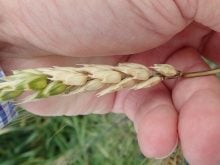As malting barley yields approach those of top feed varieties, farmers are increasingly choosing to grow malting barley in hopes of securing a premium price — even if their end goal is feed.
The problem is, those premiums don’t come easily.
Shawn Pasieczka, a food safety grain specialist with Richardson, is the arbiter of what makes the cut and what doesn’t, and ultimately whether a farmer is sitting on $1 million of malt barley or $600,000 of feed. He recently explained the factors influencing barley selection to a group of farmers at the Canadian Malt Barley Technical Centre’s (CMBTC) Producer Malt Academy, held in Winnipeg.
Read Also

Claas brings 1000 Series SP forage harvesters to Canada
In mid-August, Claas unveiled its new line of Jaguar forage harvesters at an event in Visalia, California, deep in the heart of that state’s dairy region.
Accurate samples
Pasieczka emphasized the most important step a farmer can take is ensuring the submitted sample accurately represents the entire crop.
“We need to know what that whole field looks like,” he says. “I’m looking at one kilogram to make a million-dollar deal, so that sample you give me better be what you’re actually going to deliver.”
Also, if the grain sits for an extended period, it can degrade, so he cautions farmers to re-sample the bin every six to eight weeks. If a sample meets the specifications in late summer but a load’s not delivered until the following spring, a lot can go wrong.
“Somewhere along the way, it heated, got bugs in it, or the germ dropped off,” he says. “We want to see that so we know for ourselves that you still have the malt that you said you had for us.”

Storage and handling
When storing grain, obviously you want to keep it dry. Once it gets wet, there is a risk of heating.
“The No. 1 thing when you harvest malt is to cool it down as quickly as you possibly can,” Pasieczka says. “If you can, we always recommend putting your malt on aeration.”
More generally, he says, it’s important to ensure the grain is protected from the elements.
“If you’ve got risk of any kind; if there’s spoilage, if bugs are getting in there, if we see anything like that, you’re going to be rejected,” Pasieczka warned. “If you tell me you’ve got a pile of barley in the field, it’s not malt; it’s feed. You’re going to have rabbits and goats and everything in there. Malt can’t have any excreta in it.”
Varietal purity
Different varieties will malt differently and produce different enzymes, so brewers demand variety purity, to ensure consistency for their products.
Richardson requests a minimum of 95 per cent purity — and tests for it, Pasieczka says.
“We will do a little bit of blending. So if you’re off by one or two per cent we’ll blend if we can, but anything lower than 92 per cent we’re automatically rejecting,” he says. “This is because we are selling it with a guarantee. The end users are saying we must have 95 per cent pure.”
While it is possible to re-grow your own seed, Pasieczka notes some companies require certified seed. Richardson doesn’t require certified seed, and neither do other big grain companies such as Viterra and Cargill — but for growers who use their own seed, he suggests retesting to ensure the purity is still there.

Germination
Germination is a critical part of the malting process because it activates enzymes that convert starches into fermentable sugars, which are crucial for fermentation and flavour development.
A simple test is done to determine whether a sample is viable. In a lab, 100 seeds are placed in a petri dish with four millilitres of water and kept at a constant temperature and high humidity. After three days, the germinated seeds are counted, and the number of seeds that germinate determines the viability of the sample.
Pasieczka says they test every sample that comes in, and anything lower than 95 per cent will likely be rejected. He warns this number can degrade over time.
“If you show me a sample in August at 95 per cent, you had better be hauling that in tomorrow, because it’s already dying,” he says. “By Christmas, it’s going to be 92, and by May, it’s going to be 90. It’s never going to come back to life.”
Protein
Protein in malting barley plays an important role in brewing because it supports enzyme production, flavour development and foam stability.
“If you have low protein, you don’t have enough nutrients to keep your yeast alive,” Pasieczka explains. “If you have high protein, you’re getting into issues with haze.”
Haze is caused by the presence of insoluble particles, affecting the beer’s clarity.
Pasieczka says the ideal range for protein is 10 to 12 per cent for domestic markets and 12-13.5 per cent for export markets.
“When we export to China, they’re blending it with a lot of Australian barley, which is typically down into like the nines and 10s. So they’re throwing the two together.”
While varietal genetics can play a role in protein levels, Pasieczka notes environmental factors have a much bigger impact on protein levels.
“If the barley is struggling, it’s going to tend to have higher protein,” he explains. “If you dump a pile of fertilizer on it and there’s not enough moisture to grow a proper crop, it’s going to turn that fertilizer into protein.”
Plumpness
Plumpness is important for malting barley because larger, fuller kernels typically contain more starch, which leads to higher malt extract yield and more efficient malting.
Pasieczka says the expectation for plumpness is 85 per cent. That number is determined by passing the grain through a standardized sieve. The grade is determined as a percentage of grain that either does not pass through the sieve or is lodged in the holes.
As with protein levels, genetics take a back seat to environment.
“This is something that, as a producer, you can’t control. If you didn’t get rain, you’re probably not going to have very plump barley,” said Pasieczka. “There’s a little bit of genetics involved. Some varieties definitely are plumper than others, but it’s a Mother Nature thing. There’s not much you can do about it.”
Moisture
Moisture content is crucial when selecting malting barley because too much moisture can promote mould growth and spoilage, while too little moisture can hinder germination and enzyme activation.
Pasieczka says the industry expects moisture levels in the 10-13.5 per cent range, because end users store grain in 5,000-tonne silos and want it dry before they get it, so it doesn’t spoil.
“A lot of guys don’t harvest at 13.5. They’re harvesting a little bit higher than that, just so the kernel is not as brittle coming up,” he says. “Grain that is too dry will result in more peeled and broken kernels.”
Peeled and broken kernels are a concern because they absorb moisture more quickly. The germ may still grow, but it could grow faster than everything else.
It’s fairly easy to bring 15-16 per cent moisture down to 13.5 per cent, he says, but advises that if it’s harvested much higher than that, the grower definitely needs to dry it.
“You don’t want to dry barley. It is very, very tricky to dry,” he warns. “If you overdry your barley, you’re killing the germ. Once you kill that germ, you’ve got feed barley.”

Chitting
Chitted barley has begun germinating prematurely, which can interfere with the controlled malting process.
Chitting happens when barley in the field matures and is ready to combine but then experiences a couple of days of heavy moisture. Pasieczka says Richardson will tolerate a certain level of chitting.
“We’re looking at maybe two per cent, depending on the germ,” he said. “But that two per cent is not locked in.”
Disease and herbicides
Staining is an indication of fungal loads or moulds in your crop, such as blight. Pasieczka says it’s usually not a big issue, but it causes the hull to get very thick and woody, so it absorbs moisture differently, which could lead to different germination rates. In years where the disease load is high, samples could be rejected based on staining alone.
However, a fusarium infection that produces detectable levels of DON (deoxynivalenol) raises a red flag for malt buyers. When you open a beer and it overflows slowly (not explosively, like when a beer is shaken), it is often because the beer contains DON. Barley will be rejected if DON is detected at levels above 0.5 ppm.
Ergot is another toxin that could cause barley to be rejected. China, the destination for a large portion of the barley Richardson buys, has extremely low tolerance for ergot.
“It’s not an every-year thing, and it’s usually pocketed,” Pasieczka says. “This year was very good for ergot, but two years ago, we had it everywhere.”
Glyphosate
There is essentially zero tolerance for residual glyphosate in malting barley.
“There is no pre-harvest burndown allowed, and we do test for it,” Pasieczka says. “It’s in your contracts when you sign them. There is no tolerance for glyphosate use at all.”
Every year is different
There is no single factor that is the source for the bulk of rejections of malt barley, Pasieczka says, but certain environmental conditions mean certain problems rise to the top.
“Last year we had a lot of rain at harvest. So we had a monster amount of chitting,” he says. “This year, we had no moisture in pretty much all of July. So this year we had very thin kernels.”
Ultimately, to secure the premiums malt barley can offer — now roughly $1.25 per bushel, he says — a farmer has to take control over the things within their power and otherwise hope for good luck.
















